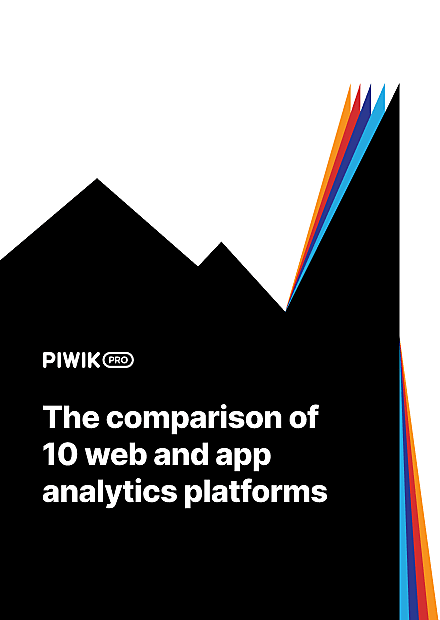Retailers face cut-throat competition. Keeping up with industry trends is essential to stay ahead in the race, especially for businesses with an omni-channel presence (often called e-tailers). Also, as a customer-centric industry, retailers are constantly under pressure to serve clients better and increase their overall satisfaction. It’s no easy task. As Shep Hyken writes in Forbes, customers will always compare you not only to your competitors, but also to the best experience they’ve had with any brand.
That’s why e-tailers need reliable analytics to help them understand their customers, gain meaningful insights and make data-driven decisions. However, for companies dealing with tons of sensitive information about their customers, choosing the right tool can be a bit of a hassle.
With this post, we’d like to show you how to overcome the issues faced by companies operating in retail and e-tail when it comes to selecting analytics and marketing platforms. We’ll enrich it with some real-life examples and experiences of one of our clients from the retail sector.
Challenge #1: Customer security first
Retailers with an online and offline presence process all kinds of user data. Typically, the list includes:
- Customer personal data gathered through loyalty platforms
- Transactional data on online purchases
- Financial data gathered through payment/credit card process
- And more
With that kind of data in your control, you need to make sure that it’s stored and processed in a way that prevents any potential data breaches. Liabilities and golden standards will differ depending on the region – data security demands tend to be stricter in Europe than in the US. However, no matter where your business is located, it’s always a good idea to have some decent data security measures in place.
Cloud data storage adds some risk, especially when it comes to handling your clients’ transactional and financial data. This information should be stored on a safe infrastructure and guarded with encryption, two-factor authentication, firewalls or other means. Cloud-based analytics and marketing platforms don’t really provide you with those options. Since their components are hosted on external servers, you have no control over them, and only limited possibilities to detect potential breaches caused by malicious code modifications.
Solution: Boost security using safe, ISO-certified data storage
Fortunately, some analytics platforms offer secure infrastructure you can easily adjust to your needs. The best option for companies processing sensitive customer data would be private cloud or on-premise data storage. These options allow you to apply additional security measures, like the ones discussed above, or other measures demanded by your internal protocols or sectoral regulations.
When choosing a vendor, look for other evidence of infrastructure security – like server redundancy, SLA uptime, maintenance support or ISO-27001 certification to name a few. When these are present, you can be sure that your data is safe and sound, right where you left it.
See how Piwik PRO ensures full security of your data.
Challenge #2: Privacy compliance without data gaps
GDPR, CCPA, LGPD…
There are more and more data privacy regulations directly impacting the way multinational companies conduct their business.
Read more here: 6 New Data Privacy Laws You Should Pay Attention To
Perhaps not all of them directly concern you. The number of new regulations, however, means that more and more companies from the retail sector have to adapt their operations to those requirements.
The main topics that keep coming up are users’ consent to data processing and the rights to:
- data access,
- deletion,
- rectification.
Respecting new users’ rights often means drastically changing the ways you collect and use their data. That’s why it’s worth considering a tool that will help you automate this process and take some of the burden off your shoulders.
Also, there’s one important thing to remember. Because users can now decline to give consent for collecting information about them, there’s a chance that after adapting to the new requirements, you’ll lose a lot of data.
That’s exactly what happened to our clients from the retail sector. Initially, right after GDPR went into effect, there was a significant drop-off in analytics data – only 6% of visitors agreed to the use of their data.
Solution: GDPR Consent Manager + Data Anonymization
A good way to overcome this problem is to use a customizable consent and data subject request manager (e.g. Piwik PRO GDPR Consent Manager) together with a data anonymization tool. This way, even if users don’t agree to their online activity being tracked, you’ll still be able to collect data about them. The information will be anonymized and limited to such bits as funnel completion rates, page views, scrolling and other action-based metrics. Still, it’s better than nothing.
When it came to our client, data made it possible to fill in the gaps and provided the information necessary for future optimizations. Also, with an optimized consent pop-up created in Piwik PRO Consent Manager, the percent of people agreeing to the use of their data increased to 36%.
To learn more about data anonymization in Piwik PRO, be sure to check this page out. Here you’ll also find some helpful use cases of anonymized data:
Anonymous Tracking: How to Do Useful Analytics Without Personal Data

COMPARISON
The comparison of 10 web and app analytics platforms
Learn the key differences between Piwik PRO Enterprise, Google Analytics 4, Matomo Cloud, Adobe Analytics, AT Internet, Countly Enterprise, Mixpanel Enterprise, Amplitude Enterprise, Snowplow Enterprise, and Heap Premier.
Challenge #3: Boosting customer satisfaction from interaction in online channels
Retail and e-tail companies reach customers in many ways, such as through leaflets, TV commercials, website banners, newsletters, outdoor campaigns and many more. They also sell via diverse channels, including online.
Things are even more complicated if an extensive online offer often includes both products and services. The primary challenge is to maintain the same level of customer experience and satisfaction both online and offline. That’s why smoothing the customer journey across websites becomes a priority.
You want to make sure that users reach certain goals on your website quickly and conveniently. It should be just as easy as finding products in a brick and mortar store.
Solution: Mapping user behavior with analytics
This is when conversion tracking comes in handy. Tracking micro and macro conversions will allow you to spot important milestones in the customer journey and measure user flow. Also, cross-domain and subdomain tracking will help you grasp multiple activities across complex offers and services.
With all that information at hand, you’ll be able to improve user flow and website navigation. It means that your customers will find information a whole lot faster. This will improve their satisfaction from the online experience and boost loyalty to your brand.
Read this post to learn more about goal tracking in Piwik PRO:
Track Piwik PRO Goals and Improve Your Online Business
Here you can find a couple of real-life use cases of conversion tracking put to work:
1) Measuring the impact of banner ads and catalogues
With a reliable tool at your disposal, you’ll be able to analyze the impact of promotional material displayed on your home page and in other key areas of your website and measure their effect on user engagement – e.g. brochure downloads or views. The data from analytics reports will show you which banners and messages were the most effective and which of them still have room for improvement.
2) Optimizing user paths
By analyzing how users navigate the website, you’ll be able to minimize the number of steps they need to take in order to reach the local branch finder subpage or promotional booklet. In the case of our client, investigating user paths and making data-backed improvements resulted in shortening the path to the goal by 35%.
3) Increasing newsletter signups
Analytics is also a great source of knowledge about the effectiveness of your newsletter. Our client gathered and acted on data related to signups for a newsletter with current offers and promotions, leading to a 17% increase in subscriptions.
Analytics implementation may seem troublesome for companies operating on multiple domains and subdomains. Never fear, this is what a secure tag manager is designed to handle. The tool allows for hassle-free tag implementation and saves time for your IT department. Here you can read more about our solution.
Challenge #4: Understanding who your customers are and what they want
Another great challenge is to get to know your audience and their preferences. As a company with a wide range of people visiting your website on a day-to-day basis, you need to be able to divide them into specific groups. Segmenting users will give you a better understanding of their behavior and show you exactly what attracts them to your brand and your offer. It will also allow you to target them with more personalized messages and promotions. And as we all know, personalization is an essential tactic for keeping customers satisfied.
Research by Segment found that 44% of consumers say that they will likely become loyal buyers after a personalized shopping experience with a company.
And 49% say they have purchased a product that they didn’t initially intend to buy after receiving a personalized recommendation.
Solution: Creating rich customer profiles and personalizing the user experience on your website
For this purpose, you’ll need some additional tools kept on your own infrastructure. In the case of Piwik PRO Analytics Suite, the combined forces of Analytics, Customer Data Platform and On-Site Retargeting will do the work. Below, we’ll show you how these tools help in your personalization efforts.
Using analytics, you’ll be able to track important customer journey interactions like items added to shopping lists, the number of promotional booklet downloads or other types of actions you find important. The information gathered by analytics will be imported into user profiles created in the CDP. What’s particularly helpful is that user profiles can be enriched with other information about clients coming from a range of different sources (e.g. CRMs, loyalty programs and more). That way you’ll be able to gather a substantial amount of information about your customers in a single database.
If you want to learn more about the capabilities of a CDP, read this post:
Customer Data Platform: What Is It and How Does It Work?
Detailed customer profiles allow you to divide your visitors into meaningful audiences. In the case of our client, they’ve build audience clusters around:
- phases in the customer journey
- trade areas and store locations
This knowledge will be a solid foundation for personalizing messaging on your website, the content of your newsletters and a lot more.
Here you can read more about the capabilities of on-site retargeting. Also, we’ve got this handy blog post:
On-Site Retargeting Strategy: The Essential Checklist
Challenge #5: Supporting marketing and sales in demand forecasting
Almost every business is constantly looking for ways to cut unnecessary costs. Demand forecasting is one of the most fruitful techniques for avoiding additional expenses. However, for reliable forecasting retailers need data from every possible source.
Solution: Analytics data as a reliable source in demand forecasting
One of the most valuable sources of information is analytics. It helps measure how online promotions influence local stores sales and the other way around – how local promotions impact user browsing patterns. Using analytics data in that context:
- results in better matching of product demands to individual stores
- shows which stores may expect more customers and when, as well as which products and offers may be the most popular
- helps anticipate the peak times and high seasons when you’ll need more employees on board
Here you’ll find a whole case study showing how Piwik PRO can help retail companies boost their online presence:
Online grocery prepared for the GDPR and optimized their website with Piwik PRO
Retail & E-tail analytics – some conclusions
Web analytics in combination with other marketing tools help retail and e-tail companies make confident and informed business decisions about both online products and local stores. But in order to fully enjoy their benefits, they must keep in mind the security and privacy of the data they process. Fortunately, there are tools on the market that meet even the highest expectations.
If you would like to learn more about how Piwik PRO helps retailers and e-tailers achieve better results without sacrificing user privacy, contact us. Our team will be happy to answer all your questions.












